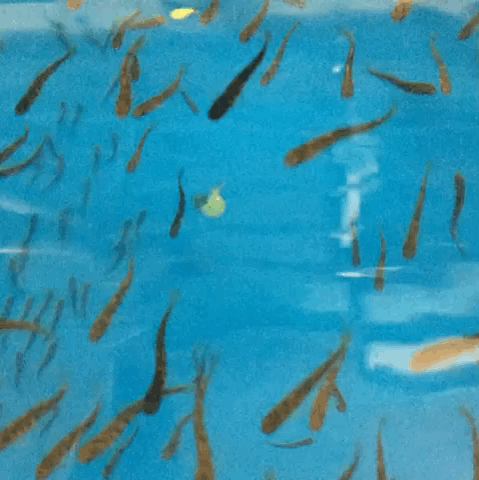The stripping of farmed fish
Every year in the first weeks of December, project work begins for us when our spawning trout are stripped. Each of these hand-picked trout comes from wild catches of regional streams or from the breeding program itself. A main task is the regular "refreshing" of the spawning fish strain in order to incorporate a maximum of genetic diversity into the breeding program. For this purpose, the fishing club Prüm 1967 eV has a fixed spawn fish in the breeding facility "In der Litzer". Here the trout experience year-round care and care and can be stripped off with minimal stress.

The seed (milk) of the male trout (Milchner) are then added to the eggs, and here too, as with spawning, several trout are streaked. Since there are usually more males than females available, the mixture is mixed in a ratio of 2 - 4, which benefits the genetic diversity due to the different mating. Water is added to the mixture for fertilization and carefully stirred with a goose feather.

When they arrive at the hatchery, the eggs are rinsed out in clear water and carefully placed in the undercurrent boxes with a counting plate. From now on, these are checked daily and dead eggs are read out. Until the eye point stage is reached, the eggs cannot be transported and unnecessary movement is avoided. We expect about 420 daily degrees for our trout. This means that at a water temperature of 6 ° C, the larvae hatch after about 70 days
The female trout (Rogner) are spread the eggs into a fine sieve with gentle pressure on the belly. The eggs are in ovarian fluid here, contact with water is largely prevented to prevent the egg membrane from closing. If you have enough eggs, put them in a smooth bowl.





Left trout larvae just before hatching. You can clearly see the eyes and the torso through the eggshell, the orange color comes from the yolk sac, from which the larvae feed in the first few weeks before being fed.
Larvae hatching and hatching below. Even if a continuous supply of fresh, oxygen-rich water is important throughout the breeding - from here on it is essential. Even brief disruptions can result in significant losses.


In late April to early May, the time has come. The trout have outgrown the hatchery and need more space to thrive. A large part is brought to the "In der Litzer" pond for further breeding. Another part is released into the upper reaches in streams leased by the association. These are not fished, but only nurtured for spawning fish at large intervals. Trout become sexually mature at the age of 2-3. First spawners are not used for breeding purposes, at 4-5 years high quality roe / milk can be obtained and the cycle closes.

